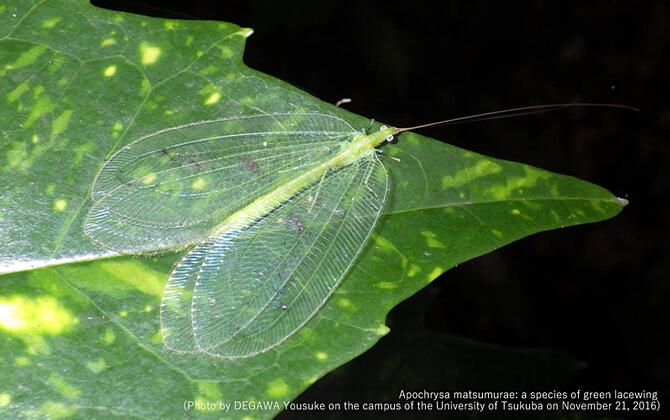Graduate Student Yuma Yoshihashi and Associate Professor Yousuke Degawa (Sugadaira Research Station, Mountain Science Center, Univ. of Tsukuba) of the Institute of Life and Environmental Sciences at the University of Tsukuba have shown that yeasts are present in the gut of a wider range of green lacewing insects than previously known, and they consist mainly of three undescribed fungal species. The results were published in the journal Antonie van Leeuwenhoek.

Provided by the University of Tsukuba
Among fungi, including mushrooms and molds, there are a wide range of species that do not produce mycelia but multiply as single cells through the processes of budding and division. Because yeasts multiply as single cells, they are suited to nutrient-containing liquid environments. Therefore, a wide variety of yeast species can be found in sap, nectar, sludge, and other liquid sources.
Insect guts are also treasure troves of yeasts, and it has been known since the 1970s that yeasts are present in the gut of lacewing insects in the Chrysopidae family. However, it remained unclear whether yeasts are universally present in the entire lacewing family, which consists of three subfamilies.
The research group collected green lacewing adults from the Sugadaira-kogen region of Nagano Prefecture, the University of Tsukuba campus in Ibaraki Prefecture, and other locations and isolated and cultured yeasts from their guts to identify and describe their taxonomic affiliation. In total, 58 green lacewings were classified into 2 subfamilies, 6 genera, and 9 species, and yeasts were successfully isolated from all of them. DNA sequence information revealed that the yeasts all belong to the genus Metschnikowia and are divided into three lineages (clades I−III).
Of these, clade I contained one undescribed species. Clade II is also a completely new lineage and has been divided into two species on the basis of the yeast morphology and physiology. Clade II was obtained from two subfamilies of the Chrysopidae family, indicating that yeasts are present in a greater diversity of green lacewings than previously known.
Considering these results, these yeasts were described as three new species in the genus Metschnikowia. Furthermore, because their shape resembles the 'biwa,' a traditional Japanese musical instrument, they have been compared to the three biwa instruments of the famous 'Noh' play and the 'Tale of the Heike,' namely 'Genjo/Kenjo,' 'Shishimaru,' and 'Seizan.' Therefore, the undescribed species with undiscovered asci (fungal sacs) in clade I was named M. shishimaru, and the two undescribed species of clade II were named M. seizan and M. kenjo, respectively.
The three biwa lutes are said to have been brought back from Tang China by Fujiwara no Sadatoshi, a Japanese envoy to the Tang dynasty. As the story goes, the Shishimaru lute produced such a wonderful sound that the eight great dragon kings on the ocean floor heard it clearly and took it to the Dragon Palace on their way to Japan. An alternative version of the story is that it was offered to the dragon kings on the ocean floor to calm the rough seas.
In the Noh play 'Tale of Genjo,' the ghost of Emperor Murakami appears at Suma Bay and orders the dragon kings to give Shishimaru to the virtuoso biwa player Fujiwara no Moronaga. Similarly, the researchers hope that the asci of this yeast species will be discovered in the near future.
Journal Information
Publication: Antonie van Leeuwenhoek
Title: Novel Metschnikowia yeasts from the gut of green lacewing in Japan
DOI: 10.1007/s10482-023-01887-0
This article has been translated by JST with permission from The Science News Ltd. (https://sci-news.co.jp/). Unauthorized reproduction of the article and photographs is prohibited.




